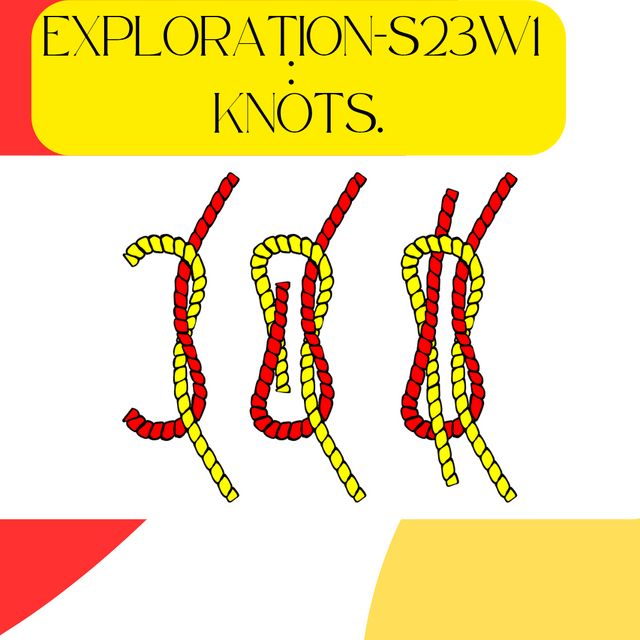
knots
Hi everyone!
Welcome to this season of the estimate engagement learning challenge. I am so excited to be back again after having a long rest. It is an amazing challenge and this time around we are going to be learning something really really important which we often use in our daily life. Knots.
I believe we are all familiar with knots As we use them almost on everyday basis, a lot is to be discussed on this. But first we have to know each type of knots and its various applications. Normally we use the traditional way but then we have to remind ourselves that every not and application has its name and meaning. Let's dive into the various type of nuts as discussed in the main lesson. Carry on some practical work on how this can be brought to life.
Practice work.
1. Have you ever tied knots? Discuss on your experience.
It is but obvious. Yes. We use knots in our daily life in performing One activity or the other. This can be in the case of joining simple ropes together anchoring stuffs at some point. The most use case I have used not is tying my shoelace And other stuffs Like anchoring animals for them feed in the grassland without running away.
This is most applicable on my Father's goat whenever I am in the village. First, applying the knot around their neck And then taking them to the bush where we tie them again somewhere else to feed on the grass. It is but oh yes that can need to be taken in order not to produce and not which will be very difficult to untie when it's time to return the back to the house.
Most often I have found difficulties on time certain nuts which are made by different persons on these animals when I am not the one who take them to the grass field in the first place. Most often the knots are so tired that loosening them is very very difficult. So I developed a strategy for tie knots which makes it very easy for me to untie the Goats when it's time to return them back home.
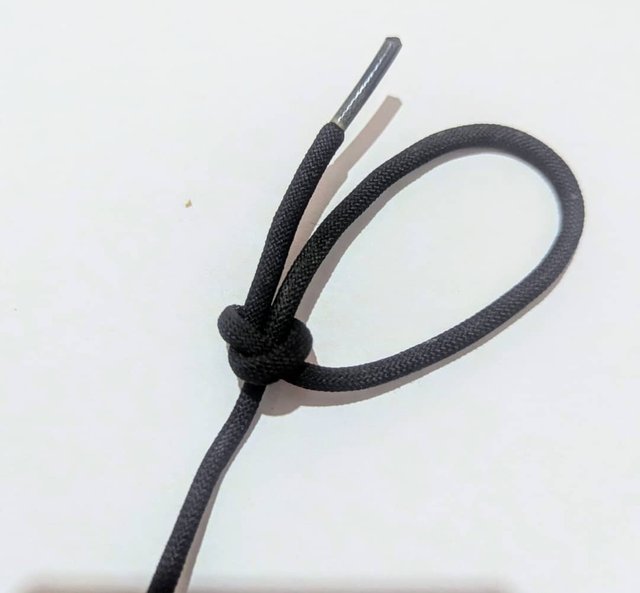
The knot in the above image it's a depiction of figure 8 knot but in essence, it is a double figure eight which makes it more durable, easy to tie on on tie.
2. Discuss On a string place its parts
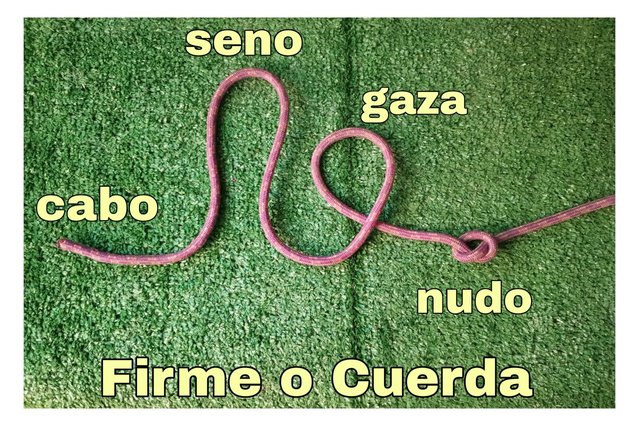
In the provided image above, We can see the various parts of its string And the applications which may be varied on it. Let's discuss on these parts.
i). CABO:
The couple is the far end of a string. It is used used in Tying knots by passing It's end true loops easily. It is very flexible and can be moved at any point. With the help of this this we can tie and untie knot at all points.
ii) SENO
This is a curve in a string which does not crosses over itself. It is widely applicable in easy time of knots, creating loops for dying animals.
iii) GAZA:
This is A loop Formed by bending The rope so that its ends crosses over another. It's provide access for uniform load distribution which makes it suitable for mountain climbing applications or knot tying.
iv) NUDO:
This is simply a knot where a roof is intertwined and secured. It's stopped free passage or slipping off When in used. It is widely applicable in time. Bandages on patience for first aid.
3. Produce a video or a gift making 3 of the 5 knots explained in the lesson.
a) Figure 8
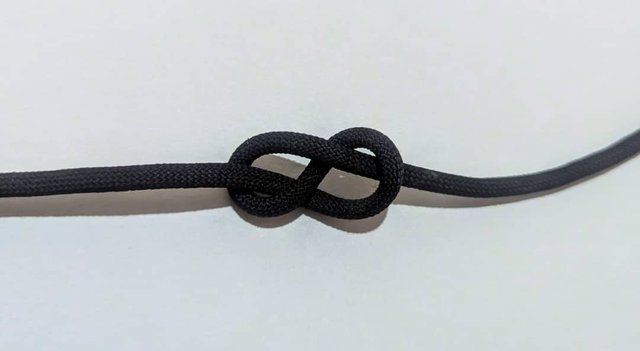 figure 8 knot
figure 8 knot
The figure 8 knot it's a widely used knot in application. Due to its durability, flexibility and easy to untie. It provide firm stops. Which makes it more widely used in complex Task such as mountain climbing and Sailing operation. It act as a firm stop at the end of the rope And equally does not slip off during High load applications.
Making a figure 8 knot.
- Begin by folding the rope in halves, forming a loop.
- past the free end on under the other half of the rope.
- This will an x-shape.
- past the remaining end over the loop
- Make the knot firm my pulling on both ends of the rope.
Video
figure 8 knot
b). Plain knot.
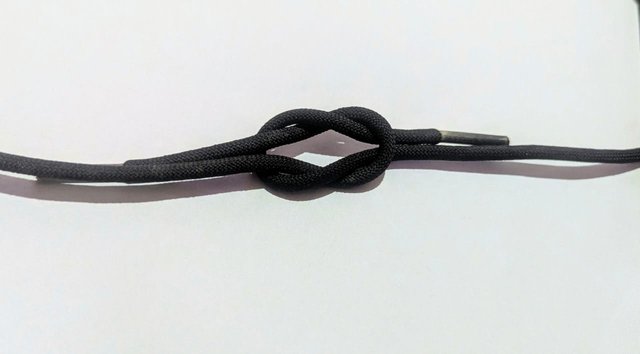 plain knot
plain knot
The plain not, or simply a flat knot is the most common type of knots used in everyday life. It is simple and easy to make as it involves just a few steps to complete. Due to its flexibility and widespread over areas, it is most applicable in the first aid such as tying bandages and also in application like tying costumes for athletes.
Making a plain knot
- start by bringing both ends of the ropes together.
- Pass the Right end over the left to form the first part.
- This direction follows the anti-clockwise movement.
- proceed by passing the write-in under the left end this time.
- This motion follows the clockwise movement.
- straighten both end of the rope to form a flat knot.
Video
plain knot
c).Guide
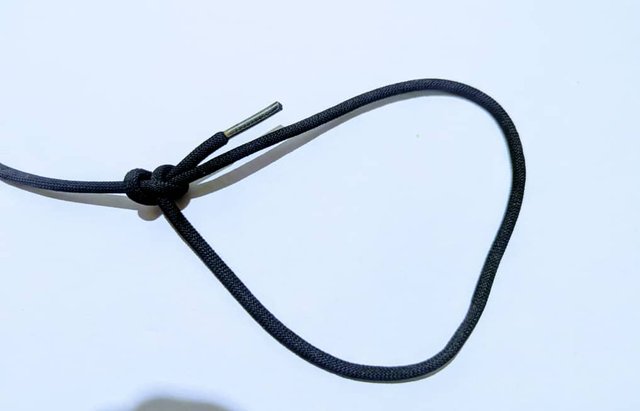 a guide knot
a guide knot
The guide is a wide spread knot Which is very common to boot humans and animals. It is often produced with the aim to maintain the distance of the required dimension in place while preventing slippage. Once the dimension have been set, the knots cannot resized by itself unless it is redone. It provides temporal anchor and maintains the strength of the knot For the required period of time.
It is widely used by climbers in mountain areas and also in animal industry or farms to tie animals for grazing or transportation. It maintains the distance between the animal's neck and the rope and doesn't choke the animal in the process.
Making a guide
- Fold the rope the road to the required Dimension and form and loop.
- guide the free end of the roof behind the look which you have created.
- From here past the free end of the rope inside the loop
- Pull on the main loop And the free end of the group to tighten your knot to the desire Dimension.
Video
Guided knot
4.What uses can you give to these knots in everyday life?
Knots are specifically useful In everyday life as they help us in several applications. Starting from anchor so application in medical fields. Both in forestry and animal livestock, let's play an important role in attaching or keeping things together.
Knots like the figure eight knot I usually applicable in areas like mountain climbing which helps anchor mountain climbers And due to the efficiency the risk of slippage is minimal. This makes them more suitable for this application. These knots I also applicable in attaching boats, sailing rescue missions.
Flat knots are applicable in first aid Which I use in the case of bandage to put a patient 's injured pads in order without causing any slippage As well as in combat spots which are mostly used by fighters to attach the customs. It is also the first application in belts attachment before revolution to modern age.
Equally guided notes are using an animal industry, especially in the grass fields which are applied around the neck of animals for support and anchor. These animals are allowed to move freely while grazing without little fear of being strangled. This is one of the big ways we see how knots I believe but
Overall, not a greatly important, not only home but in a wide variety of ways which we can possibly imagine. Therefore, it is important to have a knowledge of the various type of knots and their Mode of application.
5. Which was easier and harder to do and why?
While carrying out practice, I found out one of the simplest knots To produce was the flat knot as it involved us two step application. In just two attempts, I was able to produce it. I then go further to practice and practice more to perfect myself that aspect.
Equally. I face some difficulties capturing the figure 8 knot. It was a bit tricky at first as the windings, especially when I'm covering into an object like on the cup handle. However, after rewatching the videos for a couple of minutes, I was able to grab exactly what was missing in my tutorial. Instead of fitting it right under after passing it through the handle, I fit it in the last hole right at the bottom. This disrupted my attempt and I was not able to have desire result at first.
However, after repeating the steps over and over again I become used to it and it's now like ABC for me to do it once and again.
6. Have you made any mistakes when tying knots? What are the most common mistakes when tying knots and how can we avoid them?
Of course! Yes. Especially in the case where I was producing the guided knot. Instead of fitting The rope under as it is required, I fet it on top and trying to straighten it I discovered that there was a slippage. If this was the case of applying it on an animal neck, The animal would eventually choke.
However, correcting this it advisable to check every knot before using it once made. Equally more practice should be done in order to capture the right ways To produce knots and limits collateral damage.
Equally I found some difficulties on the figure 8 knots which I have tied it so firmly when loosening It was a bit difficult. This is something we should take more of are some nuts could be very difficult to untie when we apply too much pressure on them at some point. It is advisable to do the right thing in the right way so avoid these problems.
Last but not the least, firm knots are not a guarantee for slippage. Every knot once tied. Should be checked and checked again to make sure it is well attached before using it in any application to avoid unforeseen circumstances.
Behold, we have come to the end of our practice lesson on knots. I would say it was an amazing exercise carrying out these knots production and equally I was able to learn on the different type of knots. I have been using them. Primitively without knowing their names or the mode of application like The guided knots. Thanks to this exercise, I have learned a lot and I wish to come to you in the same light.
It was an amazing exercise and I would not hold back but invite some people so join me on here. @chant, @wirngo and @fombae
Credit to: @rafk
Check out on X
Downvoting a post can decrease pending rewards and make it less visible. Common reasons:
Submit
Upvoted! Thank you for supporting witness @jswit.
Downvoting a post can decrease pending rewards and make it less visible. Common reasons:
Submit
Wow wounderful exercise you have just done and well demonstrated in all the steps how you tied the exploration knots.Wishing you all the best for your entry .
Downvoting a post can decrease pending rewards and make it less visible. Common reasons:
Submit